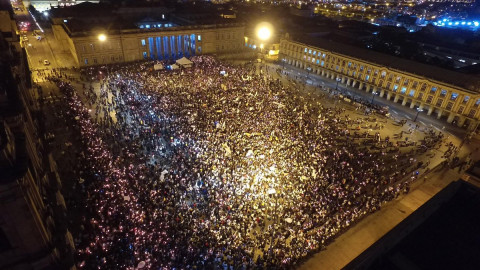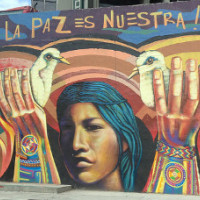On the “NO” vote to endorse the agreements and new paths to build peace in Colombia
Regions
The outcome of the October 2nd plebiscite in Colombia was a surprise for the international community and different democratic sectors in the country. It was an invitation to the Colombian population to endorse the Agreements reached between Juan Manuel Santos’ Government and the left wing guerrilla group, the Armed Revolutionary Forces of Colombia (FARC). The outcome was a surprise even among the conservative sectors and those that had opposed the Agreements, who did not expect a majority of a NO vote. The Agreements aimed to end the armed conflict with the guerrilla group which has lasted for more than 50 years.

The outcome of the plebiscite, held on October 2nd in Colombia, was a surprise for the international community and different democratic sectors in the country1. The plebiscite was an invitation to the Colombian population to endorse the Agreements reached between Juan Manuel Santos’ Government and the left wing guerrilla group, the Armed Revolutionary Forces of Colombia (FARC by its acronym in Spanish). The outcome was a surprise even among the conservative sectors and those who had opposed the Agreements, who did not expect a majority of a NO vote, even if it was a minor one. The Agreements aimed to end the armed conflict with the guerrilla group which has lasted for more than 50 years.
It can be argued that the outcome of the plebiscite was a technical tie, in which the NO vote received 50.3% while the YES vote received 49.8%2. However, it is important to analyse the situation at different levels.
In the first place, it is relevant to clarify that not everyone who voted NO made this decision with a view to perpetuate the war. A part of the population voted that way under the influence of media manipulation led by the Democratic Centre Party, headed by the senator, Alvaro Uribe Velez3. Its campaign was based on a strategy of misinformation and indignation in order to mislead an understanding of the Agreements’ content. However, popular support for peace was expressed days after the plebiscite, showing that some sectors which voted NO also endorse peace in Colombia4.
Second, the vote might also reflect the appeal of one sector of society to take part in negotiations and participate effectively beyond consultation, in which neither the methodology nor the way that the government and insurgencies attend to Colombian society’s demands and requests are clear.
Third, the influence of some sectors alike to the war is undeniable. Those sectors aim to avoid, at any cost, an agreement that brings the conflict to a positive end, since clarification of the truth about the promotion of the war and its financing might create a vulnerable situation for them. Additionally, they could lose profits and benefits obtained from the continuity of the armed confrontation5. The campaign to reject the Havana document was promoted from a perspective that fears the option of (political, environmental, and social) memory-building with the aim of preserving a hegemonic truth that maintains the power and impunity structures, which have existed historically and were strengthened during the Democratic Security period67.
In order to do this, the NO campaign appealed to the most conservative values of society, defending the heteronormative family model, private property, and the State’s existing structures8. Against a possible transitional justice, it reinforced the discourse and tools of fear to convince the population to reject the Havana Agreement.
Referring to the votes supporting the Agreement and acknowledging the fact that there is no unity in the understanding of peace or what can be expected from the so called post-conflict process, it is possible to assume that half of the people who voted supported the content of the proposals in the Havana Agreement in general. They had hopes of starting a new period in the country’s history, in which social conflicts are not processed through armed confrontation. In the same way, there is a sector of the population which expects that political participation without weapons and through democratic dialogue allows the building of environmental memory in order to produce the truth about environmental conflicts, creating a possibility of restoration of nature and therefore, an integral reparation for victims9.
Various explanations have been presented in relation to the unexpected outcome on October 2, 2016. Some of them identify voting patterns: urban-rural, conflict victims-observers, and centre-periphery10. In many cases, it is difficult to generalize voting decisions based on those patterns. It is important to consider two additional aspects of the debate, which might have influenced what happened in Colombia:
-
Rejection of the pax neoliberal, as well as the authoritarian and antidemocratic policies promoted by Santos’ Government, including a regressive tax reform and the deepening of mining-energy extractive projects along the national territory. Also, a rejection of the privatization of public services enterprises, such as ISAGEN11. In this sense, the NO vote, beyond a rejection of the Agreement might express a negative view of Santos and his country model.
-
From a historic perspective, the inability of one side of the Colombian elite (landowner) to accept even minor proposals to change the land ownership structures, as it happened with different agrarian reform proposals during 30 and 70 years in the twentieth century. As Absalon Machado explains, “The agrarian reforms were not the result of a global change process in society and they died due to the political and economic forces, who were interested in maintaining the status quo and the power structures, in societies which were on their way towards a capitalist dependent development”12.
During the week after the plebiscite, the country saw a large amount of news, which diverted the public’s attention and deepened the feeling of uncertainty about the possibility of an armed confrontation13 restarting. At the same time, an ongoing negotiation among elites about their own concepts of peace – neoliberal and traditional landowner – was evident14. Both perspectives coincide on the need to keep positive conditions for private investment, both national and transnational. Once again, as happened during the years of the creation of the Frente Nacional15, popular sectors are excluded from this negotiation.
However, social organizations and an important part of the population have been massively mobilizing in the main cities and have developed permanent mobilization and debate spaces, calling for the preservation of the Agreements, as well as to maintain the bilateral and indefinite ceasefire, and to open spaces to hear the voices of those affected by the social, environmental, and armed conflict when defining post-conflict policies16. In this sense, the opening of the public phase of negotiations with the National Liberation Army (ELN by its acronym in Spanish) is positively welcomed with the expectation of creating concrete participation spaces.
Despite the massive and politicized reaction during the days after the vote, it is important to acknowledge the high abstention on the day of the plebiscite– 62%, the highest in 22 years17. Only 37.43% of people able to vote participated in the governmental consultation. Beyond some contextual explanations, the abstention has been a historical and structural phenomenon18 that expresses the distrust of the population towards the institutions of a corporatized State, which has ruled for the elites19. This creates an even bigger challenge in relation to the definition of democracy and the building process when thinking on a country project, based on economic, environmental, and social justice.
At the international stage, some analyses have identified similarities between the outcome of the vote in Colombia and the consultations in the United Kingdom to leave the European Union (known as Brexit), or the referendum in Hungary on migration policies20. In the three cases, manipulation when using direct democracy tools (such as referenda) has been questioned because their results have been unexpected and their consequences might be harmful to the population in general21. Even though it is difficult to make generalizations as each example has complexities due to the national context beyond the specific consultation, it is important to consider again how to understand and build democracy from selective and corporatized institutions. It also raises questions about the most appropriate ways to define what can be better or worse for societies using democratic spaces, when substantial issues are at stake, such as in the case of Colombia, the ending of more than 50 years of conflict between the State and a left wing armed force.
The intense debate developed during the last weeks, including the discussion prior to the plebiscite about the Agreements and the peace proposals from different sectors and territories, has made evident that during recent years the voices of those resisting, and those who are victims of the social, economic, environmental, and armed conflict have been increasingly heard. This has happened despite attempts to hegemonize the truth and, from that point, the possibilities of political participation and building. The assumed equivalence from a few years ago of political opposition, armed rebellion, and terrorism has been questioned now, and the difference in political perspectives is accepted as an alternative way to build the country. Popular organizations might find an opportunity in this situation to communicate their proposals to other sectors of society and continue moving forward to seed a just, solidary and sustainable Colombia.
Finally, after the decision to give the Nobel Peace Prize to Juan Manuel Santos, the view of the international community and its support to quickly implement the Agreements with the FARC seem explicit as one of the steps towards peace building, which undoubtedly is the hope of most of the Colombian population, who have suffered throughout the war.
1 http://www.nytimes.com/2016/10/03/world/colombia-peace-deal-defeat.html, https://www.washingtonpost.com/news/monkey-cage/wp/2016/10/03/colombia-just-voted-no-on-its-referendum-for-peace-heres-why-and-what-it-means/ http://www.bbc.com/news/world-latin-america-37537252
2 http://plebiscito.registraduria.gov.co/99PL/DPLZZZZZZZZZZZZZZZZZ_L1.htm
3 Campaign Video: https://www.youtube.com/watch?v=-2wiy26x198#action=share. Interview to Juan Carlos Velez Uribe, NO campaign chief, explaining their strategy: http://www.larepublica.co/el-no-ha-sido-la-campa%C3%B1a-m%C3%A1s-barata…
4 http://noticias.caracoltv.com/acuerdo-final/marea-blanca-se-toma-bogota…
5 http://www.nytimes.com/es/2016/10/14/alvaro-uribe-el-hombre-que-esta-bloqueando-la-paz-en-colombia/ http://www.semana.com/opinion/articulo/joaquin-robles-zabala-de-que-habla-uribe-cuando-habla-de-impunidad/485171 http://www.elpais.com.co/elpais/colombia/noticias/alvaro-uribe-velez-no…
6 Alvaro Uribe’s programme was called “Democratic Security”. http://www.alvarouribevelez.com.co/es/content/seguridad-democratica
7 See Interview to Juan Carlos Velez, quoted above.
8 http://www.semana.com/nacion/articulo/alejandro-ordonez-habla-del-proceso-de-paz-el-gobierno-santos-la-ideologia-de-genero-y-el-plebiscito/495287
9 http://censat.org/es/noticias/por-la-continuidad-del-proceso-de-negocia…
10 http://www.infobae.com/america/america-latina/2016/10/03/region-por-region-que-ciudades-de-colombia-votaron-si-al-acuerdo-de-paz-con-las-farc-y-cuales-le-dieron-la-espalda/ http://cnnespanol.cnn.com/2016/10/03/colombia-los-departamentos-con-mas…
11 http://www.elheraldo.co/politica/analisis-ley-del-montes-venta-de-isage…
12 Machado, Absalón. Esbozo de una Memoria Institucional. La política de Reforma Agraria y Tierras en Colombia. Centro Nacional de Memoria Histórica. 2013. Pg 39
13 http://www.elespectador.com/noticias/paz/cese-al-fuego-bilateral-va-has…
14 http://www.elespectador.com/noticias/paz/cese-al-fuego-bilateral-va-has…
15 Historian Mauricio Archila defines the Frente Nacional as “The bi-party coalition regime that ruled in Colombia between 1958 and 1974, which has the merit of attenuate the political color confrontation but deepened the social gap, producing new enmities in the country”. During this period, the presidential elections were alternated between Liberal and Conservative parties, with the aim of overcoming the armed confrontation among those parties during the previous period, known as “The Violence”. Archila, Mauricio, EL FRENTE NACIONAL: UNA HISTORIA DE ENEMISTAD SOCIAL. En: Anuario Colombiano de Historia Social y de la Cultura 24, 1997.
16 https://mesasocialpaz.wordpress.com/ https://www.facebook.com/PazALaCalleP/ http://colombiaplural.com/organizaciones-proponen-una-cumbre-nacional-p…
17 http://www.eltiempo.com/politica/proceso-de-paz/abstencion-en-el-plebis…
18 http://www.semana.com/nacion/articulo/abstencion-problema-historico/117376-3 http://www.efe.com/efe/usa/politica/oea-recomienda-a-colombia-medidas-c…
19 http://www.bbc.com/mundo/noticias-america-latina-37539590
20 https://www.theguardian.com/world/2016/jul/22/colombia-plebiscite-farc-vote-brexit
21 http://www.nytimes.com/2016/10/05/world/americas/colombia-brexit-referendum-farc-cameron-santos.html?_r=0 http://qz.com/799824/from-brexit-to-colombia-this-is-turning-into-the-n…

